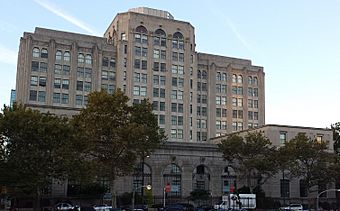Board of Education Building (Philadelphia) facts for kids
Quick facts for kids |
|
|
Board of Education Building
|
|
 |
|
| Location | 21st St. and Benjamin Franklin Pkwy., Philadelphia, Pennsylvania |
|---|---|
| Area | less than one acre |
| Built | 1930 |
| Architect | Irwin T. Catharine; Jules A. Melidon |
| Architectural style | Classical Revival, Moderne, Neo-Classical |
| NRHP reference No. | 83002266 |
| Added to NRHP | August 25, 1983 |
The Board of Education Building is a very old and important building in Philadelphia, Pennsylvania. It is located in the Logan Square area. For many years, this building was the main office for the School District of Philadelphia. This means it was the center of all the schools in the city.
The building was finished in 1932. It was added to the National Register of Historic Places in 1983. Today, it is no longer used for schools. Instead, it has been changed into homes for people to live in.
Contents
Building's Cool Design and Art
The way the Board of Education Building looks was chosen by a special group of experts. Its style mixes two cool types of architecture: Art Deco and Classical Revival. This mix is often called Moderne. This building was part of an early plan to make the city look better. This plan also led to the creation of the Benjamin Franklin Parkway.
Sculptures with Educational Themes
The building has special carvings called bas-relief sculptures. These carvings show different ideas about education. The architect, Irwin T. Catharine, first drew these ideas. Then, an artist named Jules Melidon made them into plaster models. Finally, stone cutters carved them into the building's stone.
Famous Thinkers on the Walls
You can see busts, which are sculptures of people's heads and shoulders, on top of the four columns on each side of the building's central tower. These busts honor great thinkers, teachers, and leaders.
- North side: Daniel Webster, Benjamin Franklin, Thaddeus Stevens, William Shakespeare
- South side: Alexander Graham Bell, Thomas Jefferson, Abraham Lincoln, John Marshall
- East side: Robert Fulton, Russell Conwell, Horace Mann, William Penn
- West side: Isaac Newton, George Washington, Bayard Taylor, Stephen Girard
Building Photos
-
This photo shows the building from across the Benjamin Franklin Parkway. You can see it between the Franklin Institute and the Cira Centre.









